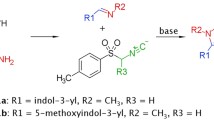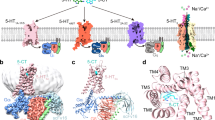Abstract
[3H]LY334370 was developed as a radioligand to study the characteristics of this compound’s interaction with the 5-HT1F receptor. Monovalent or divalent cations did not enhance the binding of [3H]LY334370 to the cloned human 5-HT1F receptor. In the presence of MgCl2, the time to reach equilibrium was approximately 2 h, while in its absence equilibrium was reached in less than 1 h. [3H]LY334370 had high affinity for the cloned human 5-HT1F receptor (Kd=0.446 nM) and the 5-HT1F receptor in rat brain (Kd=0.388 nM). The expression density of 5-HT1F receptors, as determined by binding to homogenates of cortical regions from rat, was low (Bmax=79.1 fmol/mg protein). There was a statistically significant correlation between the apparent pKi for inhibition of [3H]LY334370 binding and the pEC50 for stimulation of [35S]GTPγS binding to homogenates of cells expressing the cloned human 5-HT1F receptor. In addition, there was a statistically significant correlation between the apparent pKi for inhibition of [3H]LY334370 binding to the cloned human 5-HT1F receptor and the pID50 for inhibition of trigeminal nerve stimulated dural plasma protein extravasation in the guinea pig. The conclusion from these studies is that [3H]LY334370 is a high affinity radioligand which can be used for the study of the 5-HT1F receptor in rat brain or in cells transformed with the human 5-HT1F receptor.








Similar content being viewed by others
References
Adham N, Kao H-T, Schechter LE, Bard J, Olsen M, Urquhart D, Durkin M, Hartig PR, Weinshank RL, Branchek TA (1993) Cloning of another human serotonin receptor (5-HT1F): a fifth 5-HT1 receptor subtype coupled to the inhibition of adenylate cyclase. Proc Natl Acad Sci USA 90:408–412
Adham N, Bard JA, Zgombick JM, Durkin MM, Kucharewicz S, Weinshank RL, Branchek TA (1997) Cloning and characterization of the guinea pig 5-HT1F receptor subtype: a comparison of the pharmacological profile to the human species homolog. Neuropharmacology 36:569–576
Alberts GL, Pregenzer JF, Im WB, Slightom JL (2000) Cloning of serotonin 5-HT1 receptor subtypes from the chimpanzee, gorilla and rhesus monkey and their agonist-induced guanosine 5′γ35S triphosphate binding. Neurosci Lett 280:223–227
Amlaiky N, Ramboz S, Boschert U, Plassat J-L, Hen R (1992) Isolation of a mouse “5HT1E-like” serotonin receptor expressed predominantly in hippocampus. J Biol Chem 267:19761–19764
Bhalla P, Sharma HS, Wurch T, Pauwels PJ, Saxena PR (2002) Molecular cloning and expression of the porcine trigeminal ganglion cDNA encoding a 5-ht1F receptor. Eur J Pharmacol 436:23–33
Castro ME, Pascual J, Romón T, Del Arco C, Del Olmo E, Pazos A (1997) Differential distribution of [3H]sumatriptan binding sites (5-HT1B, 5-HT1D and 5-HT1F receptors) in human brain: focus on brainstem and spinal cord. Neuropharmacology 36:535–542
Cheng Y-C, Prusoff WH (1973) Relationship between the inhibition constant (Ki) and the concentration of inhibitor which causes 50 percent inhibition (I50) of an enzymatic reaction. Biochem Pharmacol 22:3099–3108
De Lean A, Hancock AA, Lefkowitz RJ (1982) Validation and statistical analysis of a computer modeling method for quantitative analysis of radioligand binding data for mixtures of pharmacological receptor subtypes. Mol Pharmacol 21:5–16
Dupuis DS, Colpaert FC, Pauwels PJ (1998) G-protein activation at 5-HT1A receptors by the 5-ht1F ligand LY334370 in guinea-pig brain sections and recombinant cell lines. Br J Pharmacol 124:283–290
Glowinski J, Iversen LL (1966) Regional studies of catecholamines in the rat brain. I. The disposition of [3H]norepinephrine, [3H]dopamine and [3H]DOPA in various regions of the brain. J Neurochem 13:655–669
Goldstein DJ, Roon KI, Offen WW, Ramadan NM, Phebus LA, Johnson KW, Schaus JM, Ferrari MD (2001) Selective serotonin 1F (5-HT1F) receptor agonist LY334370 for acute migraine: a randomised controlled trial. Lancet 358:1230–1234
Hall MD, El Mestikawy S, Emerit MB, Pichat L, Hamon M, Gozlan H (1985) [3H]8-Hydroxy-2-(di-n-propylamino)tetralin binding to pre- and postsynaptic 5-hydroxytryptamine sites in various regions of the rat brain. J Neurochem 44:1685–1696
Hall MD, Gozlan H, Emerit MB, El Mestikawy S, Pichat L, Hamon M (1986) Differentiation of pre- and post-synaptic high affinity serotonin receptor binding sites using physico-chemical parameters and modifying agents. Neurochem Res 11:891–912
Harikumar KG, Chattopadhyay A (1998) Metal ion and guanine nucleotide modulations of agonist interaction in G-protein-coupled serotonin1A receptors from bovine hippocampus. Cell Mol Neurobiol 18:535–553
Herrick-Davis K, Titeler M (1988) Detection and characterization of the serotonin 5-HT1D receptor in rat and human brain. J Neurochem 50:1624–1631
Johnson KW, Schaus JM, Durkin MM, Audia JE, Kaldor SW, Flaugh ME, Adham N, Zgombick JM, Cohen ML, Branchek TA, Phebus LA (1997) 5-HT1F receptor agonists inhibit neurogenic dural inflammation in guinea pigs. NeuroReport 8:2237–2240
Lovenberg TW, Erlander MG, Baron BM, Racke M, Slone AL, Siegel BW, Craft CM, Burns JE, Danielson PE, Sutcliffe JG (1993) Molecular cloning and functional expression of 5-HT1E-like rat and human 5-hydroxytryptamine receptor genes. Proc Natl Acad Sci USA 90:2184–2188
Pascual J, Del Arco C, Romón T, Del Olmo E, Pazos A (1996) [3H]Sumatriptan binding sites in human brain: regional-dependent labelling of 5-HT1D and 5-HT1F receptors. Eur J Pharmacol 295:271–274
Rasmussen K, Calligaro DO, Czachura JF, Dreshfield-Ahmad LJ, Evans DC, Hemrick-Luecke SK, Kallman MJ, Kendrick WT, Leander JD, Nelson DL, Overshiner CD, Wainscott DB, Wolff MC, Wong DT, Branchek TA, Zgombick JM, Xu Y-C (2000) The novel 5-hydroxytryptamine1A antagonist LY426965: effects on nicotine withdrawal and interactions with fluoxetine. J Pharmacol Exp Ther 294:688–700
Rosenthal HE (1967) A graphic method for the determination and presentation of binding parameters in a complex system. Anal Biochem 20:525–532
Swillens S (1992) How to estimate the total receptor concentration when the specific radioactivity of the ligand is unknown. Trends Pharmacol Sci 13:430–434
Szele FG, Pritchett DB (1993) High affinity agonist binding to cloned 5-hydroxytryptamine2 receptors is not sensitive to GTP analogs. Mol Pharmacol 43:915–920
Waeber C, Moskowitz MA (1995) [3H]Sumatriptan labels both 5-HT1D and 5-HT1F receptor binding sites in the guinea pig brain: an autoradiographic study. Naunyn-Schmiedeberg’s Arch Pharmacol 352:263–275
Wainscott DB, Lucaites VL, Kursar JD, Baez M, Nelson DL (1996) Pharmacologic characterization of the human 5-hydroxytryptamine2B receptor: evidence for species differences. J Pharmacol Exp Ther 276:720–727
Wainscott DB, Johnson KW, Phebus LA, Schaus JM, Nelson DL (1998) Human 5-HT1F receptor-stimulated [35S]GTPγS binding: correlation with inhibition of guinea pig dural plasma protein extravasation. Eur J Pharmacol 352:117–124
Acknowledgements
The authors would like to thank Synaptic Pharmaceutical Corporation for providing the cells expressing the cloned human 5-HT1F receptor and for the radioligand binding assay characterization of LY334370 at the 5-HT1A, 1B, 1D, 1E, 1F, 4, 6 and 7 receptors.
Author information
Authors and Affiliations
Corresponding author
Rights and permissions
About this article
Cite this article
Wainscott, D.B., Krushinski, J.H., Audia, J.E. et al. [3H]LY334370, a novel radioligand for the 5-HT1F receptor. I. In vitro characterization of binding properties. Naunyn-Schmiedeberg's Arch Pharmacol 371, 169–177 (2005). https://doi.org/10.1007/s00210-005-1035-9
Received:
Accepted:
Published:
Issue Date:
DOI: https://doi.org/10.1007/s00210-005-1035-9




